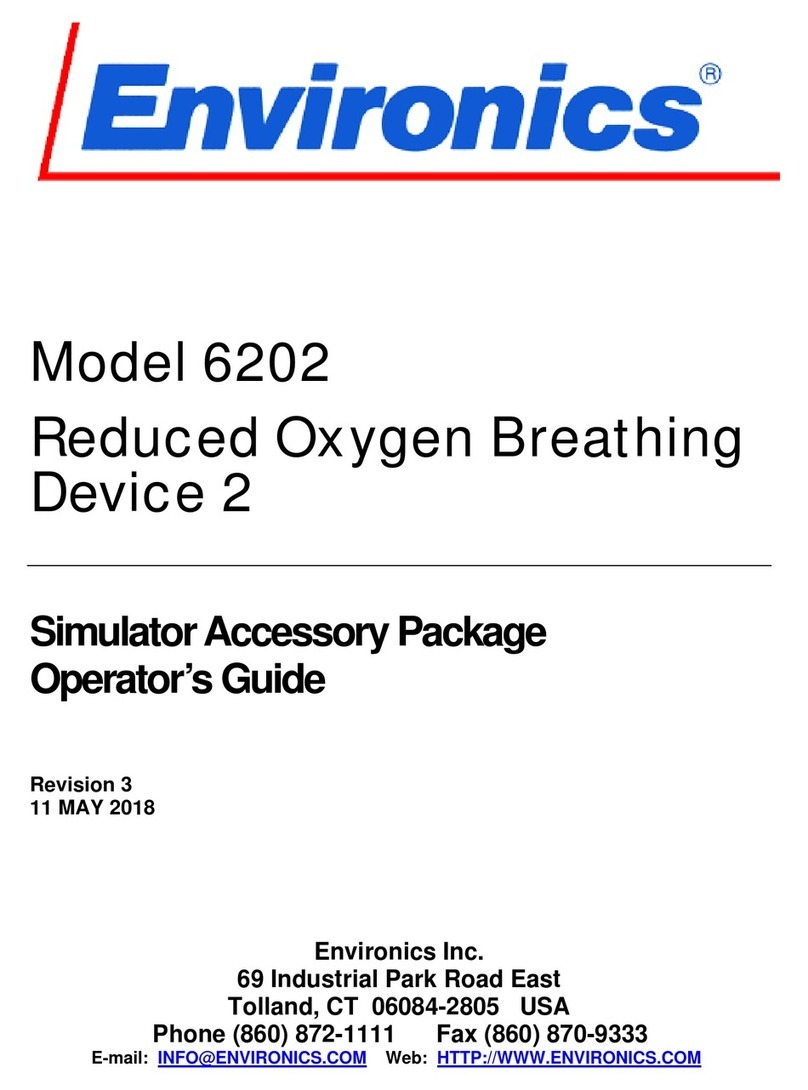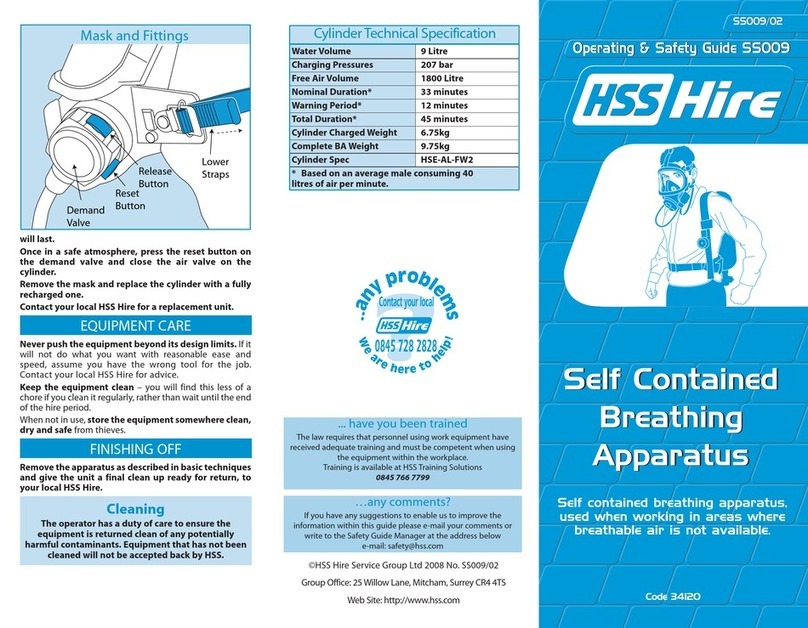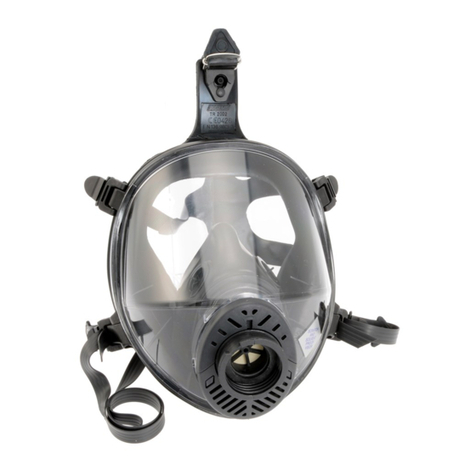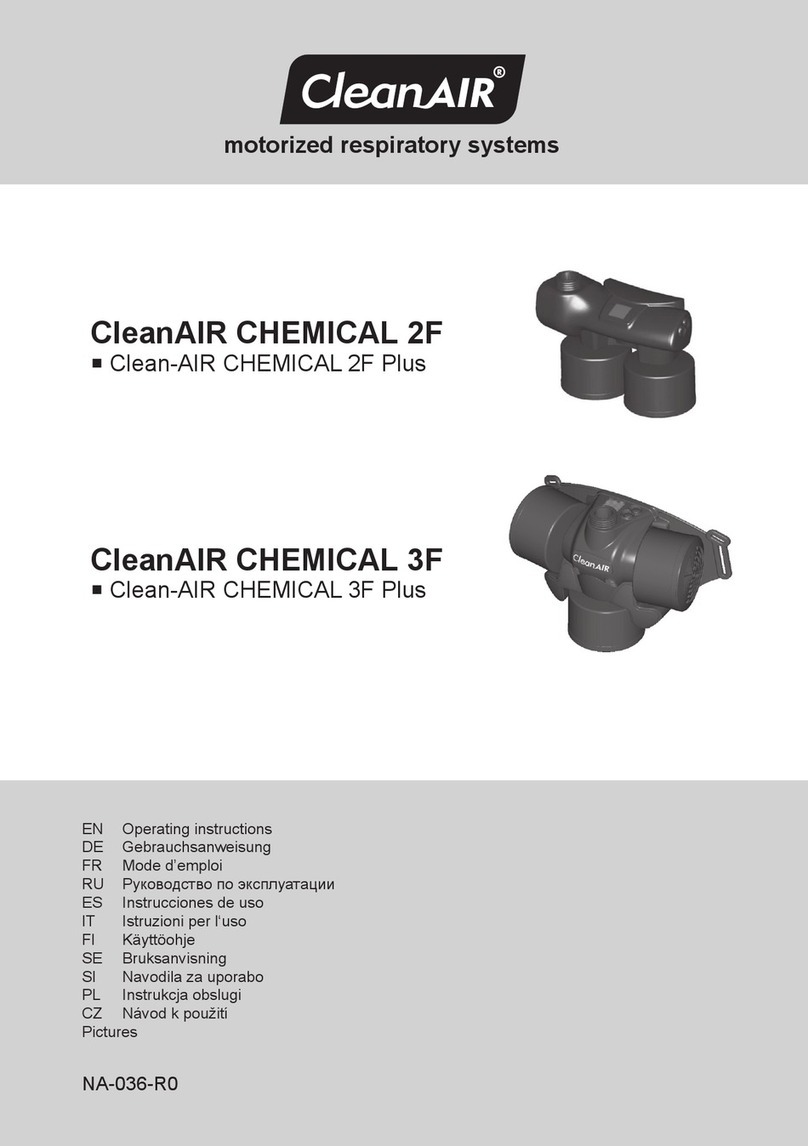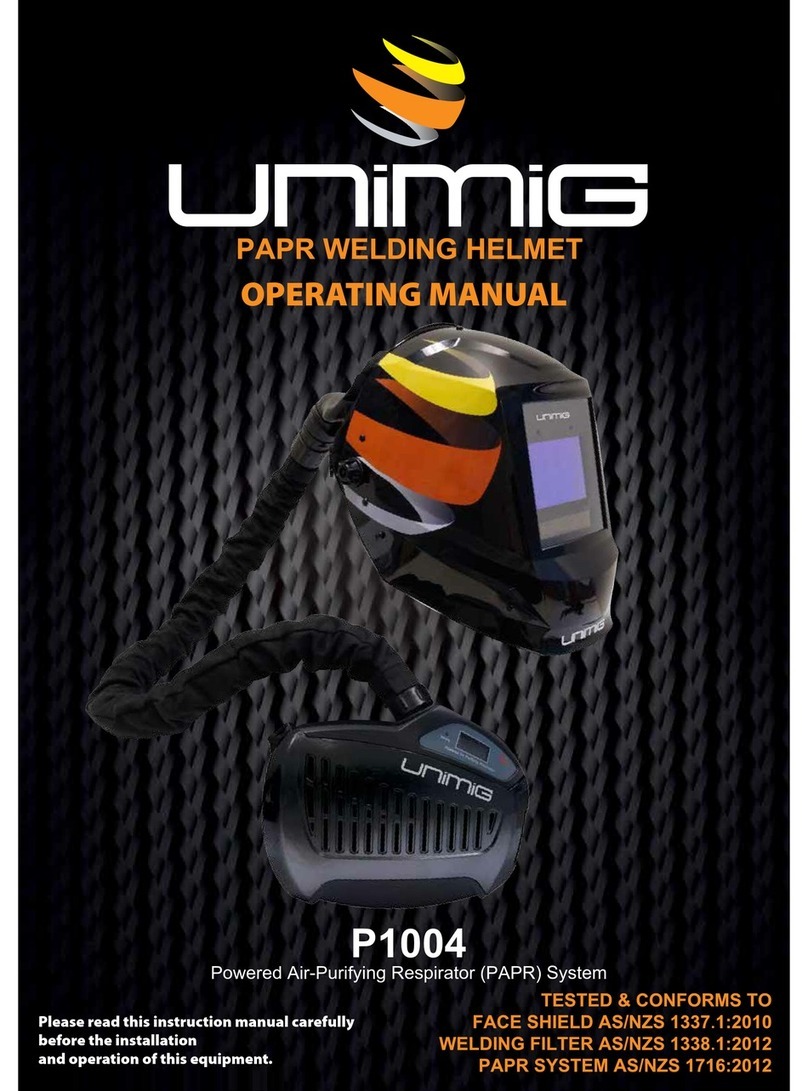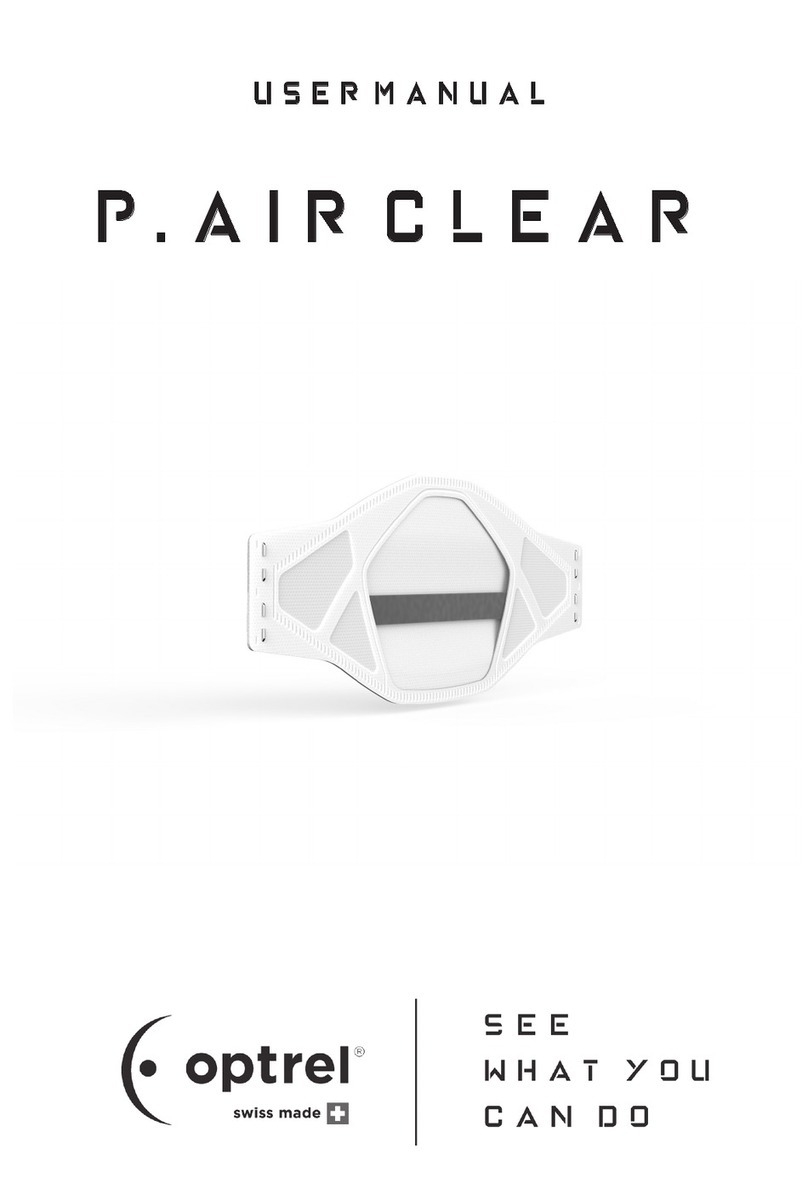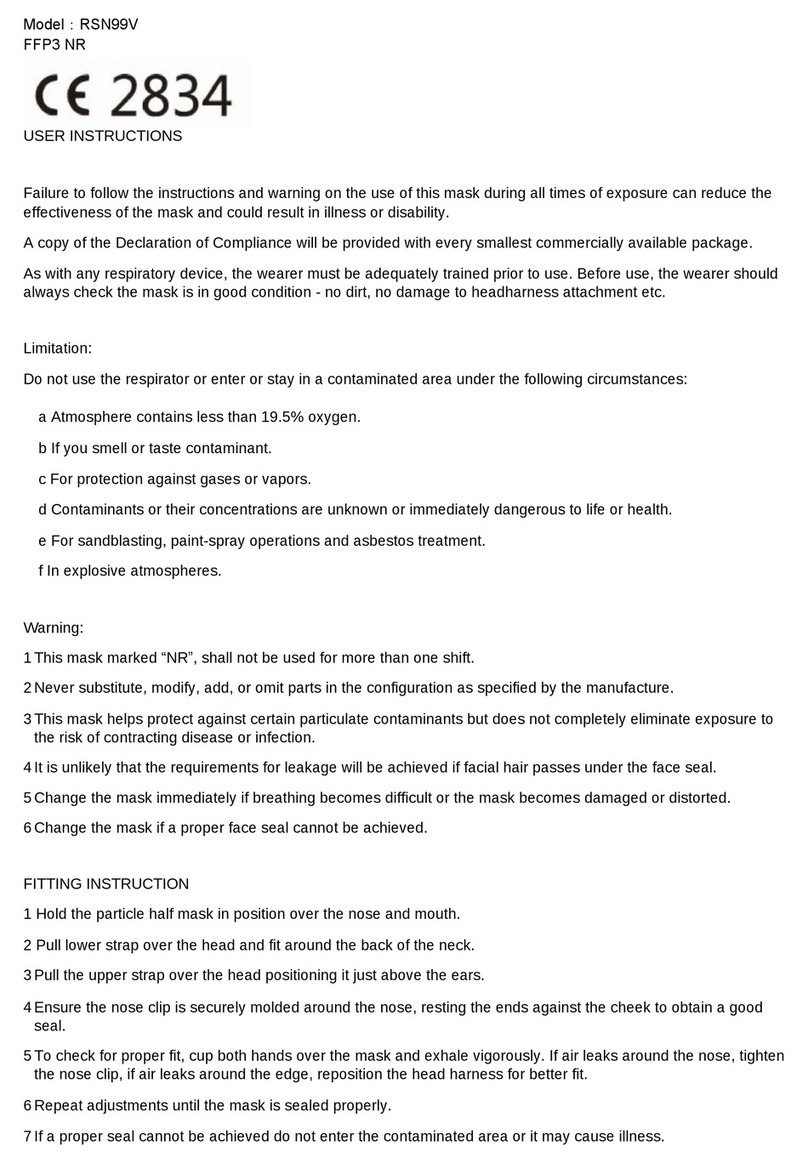Environics 6202-1 Manual

Model 6202-1
Reduced Oxygen Breathing
Device 2
Operator’s Guide
Revision 8
September 2nd 2016
Software Rev. 6202-2.00-XX
Environics Inc.
69 Industrial Park Road East
Tolland, CT 06084-2805 USA
Phone (860) 872-1111 Fax (860) 870-9333
E-mail: [email protected] Web: HTTP://WWW.ENVIRONICS.COM

II
COPYRIGHT
© 2016 Environics Inc. All Rights Reserved. This manual and the software contained
within the product(s) described are copyrighted with all rights reserved.
TRADEMARKS
Environics is a registered trademark of Environics Inc. All other brand names,
company names and product names mentioned are the property of their respective
owners.
PATENTS
This product is licensed from the U.S. Navy under U.S. Patent Application No.
10/959.764
WARRANTY
Environics Inc. warrants this product to be free from defects in material and
workmanship for a period of one year from the date of shipment. Environics warrants
the following expendable items for 30 days from the date of shipment: fuses, lamps,
batteries. During the warranty period, Environics will, at our option, either repair or
replace any product that proves to be defective.
To exercise this warranty, contact Environics at the address below for assistance and
instructions for returning the products. Repaired or replaced products are warranted
for the balance of the original warranty period or at least 30 days.
LIMITATION OF WARRANTY
This warranty does not apply to defects resulting from product modification made
without Environics’ express written consent, or misuse of any product or part. This
warranty also does not apply to software, damage from battery leakage or problems
arising from normal wear or failure to follow instructions.
This warranty is in lieu of all other warranties, expressed or implied, including any
implied warranty of merchantability or fitness for a particular use. The remedies
provided herein are the buyer’s sole and exclusive remedies.
Neither Environics nor any of its employees shall be liable for any direct, indirect,
special, incidental or consequential damages arising out of the use of its instruments
and software even if Environics has been advised in advance of the possibility of
such damages. Such excluded damages shall include, but are not limited to: costs of
removal and installation, losses sustained as the result of injury to any person or
damage to property.
WARNING
READ THIS MANUAL CAREFULLY BEFORE USING THIS INSTRUMENT.
FAILURE TO DO SO MAY VOID THE WARRANTY,
DAMAGE THE INSTRUMENT OR CAUSE SERIOUS INJURY.

III
ROBD2 Operator’s Guide changes
Manual
Revision
#
Software
Revision
#
Manual
Release
Date
Enhancements
1 0.93-XX 11/1/2004 Initial release
2 0.96-XX 10/26/2005
Added MFC safety feature, changed fitting color codes, reduced
maximum altitude to 34K feet, modified self-tests, added purge to pilot
test menu, added purge after test altitudes (self calibration)
3 0.96-XX 02/09/2006
Fixed erroneous information and typographical errors
Added statement (bottom page 1) Added Breathing loop pressure port
(Bottom page 6), Added safety feature (Top page 31)
4 0.96-XX 04/26/2006 Modified O2 dump screen (page 29).
5 0.96-XX 9/27/2006 Added restrictions to connecting pulse oximeter probe (pages 3, 10 & 12)
Added note about powering on the pulse oximeter in Quick start (page 10)
6 0.97-xx 5/5/2010 Added O2 DUMP PRESSURE setting to OPTION menu
Modified O2 Dump and O2 Pressure safety feature section
Corrected Patent information
7 2.00-XX 7/30/2016 Updated manual to include modifications made for new model 6202-1
8 2.00-XX 9/2/2016 Added information about the vent plug in the vent port

I
V
TABLE OF CONTENTS
LIST OF FIGURES v
LIST OF ABBREVIATIONS / ACRONYMS vi
OVERVIEW 1
SYSTEM LAYOUT 2
Front Panel Layout 2
Rear Panel Layout 4
UNPACKING AND INSTALLATION 7
Standard packaging and unpacking 7
Transport case option and unpacking 7
Installation 7
POWER AND GAS CONNECTIONS 8
Power Connection 8
Gas Connection 9
QUICK START PROCEDURE 10
POWER UP AND SELF-TESTS 11
Power up 11
Warmup 11
Self-test/calibration 11
Self-test Operations 12
Self Calibration Operations 13
SYSTEM OPERATION 15
Entering data 15
Main Screen - Ready mode 16
START – Pilot Test mode 17
Option menu 21
SAFETY FEATURES 26
PULSE OXIMETER 28
SpO2 and Pulse Rate Displays 28
SpO2 and Pulse Rate Alarms 29

V
LIST OF FIGURES
FIGURE 1 - FRONT PANEL LAYOUT .................................................................. 2
FIGURE 2 - REAR PANEL LAYOUT .................................................................... 4
FIGURE 3 - P&ID ................................................................................................ 34

VI
LIST OF ABBREVIATIONS / ACRONYMS
AC Alternating Current
EMI Electromagnetic Interference
HZ Hertz
LCD Liquid Crystal Display
LPM Liters Per Minute
MFC Mass Flow Controller
NAG Nitrogen and Air Generator
P&ID Piping and Instrument Diagram
PSIG Pounds Per Square Inch Gauge
RFI Radio Frequency Interference
SUT Subject Under Test
VAC Volts, Alternating Current
VDC Volts, Direct Current

OVERVIEW
ROBD2 USER’S GUIDE SEPTEMBER 2016
1
OVERVIEW
The second generation Reduced Oxygen Breathing Device (ROBD2) is a
computerized gas-blending instrument. The system uses Thermal Mass Flow
Controllers (MFC) to mix breathing air and nitrogen to produce the sea level
equivalent atmospheric oxygen contents for altitudes up to 40,000 feet. The
MFCs are calibrated on primary flow standards traceable to the National Institute
of Standards and Technology (NIST). NIST is a federal agency whose mission is
to develop and promote measurement, standards, and technology to enhance
productivity, facilitate trade, and improve the quality of life. Several safety
features are built into the ROBD2 to prevent over-pressurization of the Pilot’s
mask and to prevent reduced oxygen contents below those being requested for a
particular altitude. The software is Menu driven. The main operator’s menu
consists of three selections, simplifying the use of the system for the field
operator. Built in self-tests verify all system component functionality before the
operation of the system can begin. If any self-tests fail, the system will not
operate.
This manual contains information and guidance for setting up and operating the
ROBD2.
Step by step instructions are provided for connecting power and gas sources,
running self-tests, running the self-calibration routines and running a pre-
programmed sequence of altitudes on the subject under test (SUT).
Descriptions of alarms and safety features are provided along with actions to be
taken in the event of an alarm condition.
A piping and instrument diagram (P&ID) is provided on the last page of the
manual for an overview of the electrical, pneumatic and electro-pneumatic
components contained within the instrument.
IMPORTANT: The ROBD2 operator should be certified in first-aid and CPR and
have access to communication in the event of an emergency.
Prior to participation in ROBD2 training or research, the subject under test should
have the equivalent to a FAA physical of any class or military flight physical and
be screened for current health status prior to the run.

SYSTEM LAYOUT
ROBD2 USER’S GUIDE SEPTEMBER 2016
2
SYSTEM LAYOUT
Front Panel Layout
Figure 1 - Front panel layout

SYSTEM LAYOUT
ROBD2 USER’S GUIDE SEPTEMBER 2016
3
LCD Display
The liquid crystal display (LCD) is a four line, 20 characters display, protected by a
clear lens. The display is illuminated when the system is in operation.
Function Keys
Three function keys (F1, F2 and F3), located below the display, and are used to
make various selections from the menu displayed on the bottom line of the screen.
The current function of each key is displayed above each function key The function of
each key will change, depending on the current operating mode.
Advance and Stop keys (program)
The ADVANCE and STOP keys are used while running a program in the Pilot Test
Mode (START mode). The STOP key aborts the program immediately upon pressing
the key. The ADVANCE key immediately advances the program to the next step.
Numeric Keypad
The numeric keypad is used for data entry of numbers 0 through 9 and a decimal
point. Pressing the ENTER key completes the entry of the numeric data selected.
Arrow Keys
The arrow keys are used to move the cursor on the display screen to and from
different fields located on the different entry screens or to scroll up or down a menu or
list of information. Pressing and holding the arrow keys will cause them to repeat.
Menu Key
The MENU key has no function while the system is in the Operator’s mode. This key
is used to move between multiple menus while the system is in the Administrator
(ADMIN) mode. The ADMIN mode is restricted to those who program the ROBD2.
Oxygen dump switch
This emergency stop switch causes the supply of 100% 02 to the subject under test.
Breathing mask connector
This female connection port (MS 22058-1), with spring-loaded cover, is for the pilot’s
breathing mask connection.
Pulse oximeter
The new 6202-1 pulse oximeter has a color touch screen. The details of the pulse
oximeter are covered in the pulse oximeter section of this manual

SYSTEM LAYOUT
ROBD2 USER’S GUIDE SEPTEMBER 2016
4
Rear Panel Layout
Figure 2 - Rear panel layout

SYSTEM LAYOUT
ROBD2 USER’S GUIDE SEPTEMBER 2016
5
Power Input
The power entry module supplies AC power to the internal power supplies. The
internal power supplies convert and regulate the AC signal to the five DC voltages
required by the system electronics. The power entry module has integrated EMI/RFI
filtration and switch one or both hot lines dependent upon 110 or 220 VAC operation.
The power entry module also has two replaceable fuses.
Gas Inputs
These gas inputs supply source gas to the system components. The optional quick
connect fittings for these ports are colored and keyed. The Nitrogen input is black,
the Air input is yellow and the oxygen input is green. The Nitrogen and air inputs
should be pressurized to a dynamic pressure of 40 PSIG and the oxygen input
should be adjusted to a dynamic pressure of 20 PSIG.
RS-232 Port
One 9-pin RS-232 serial port is connected to the embedded controller of the ROBD
system. This port is used for remote control of the ROBD2 using a host computer
and communications software. Communication protocol is provided in the
programming and technical guide. This protocol can be used to develop control and
data collection programs using programs such as National Instruments’ LabVIEW.
Cooling fan
The cooling fan moves approximately 36 cu/ft per minute of filtered air through the
ROBD chassis and out the cooling vents on the top cover of the chassis. The cooling
fan should not be obstructed.
Service port
The service port is used for factory calibration of the thermal mass flow
controllers.
Important: The silver plug must not be removed during normal operation.
Pulse oximeter probe connector
Plug the pulse oximeter probe into this port. Once connected the probe is
latched. The probe is removed, by pressing the side tabs on the probe connector
and pulling it out.

SYSTEM LAYOUT
ROBD2 USER’S GUIDE SEPTEMBER 2016
6
Vent port
This port vents the excess flow of gas not used during inhalation and exhalation and
also limits the pilot mask pressure.
Important: A filtered vent plug has been installed into the vent port. This vent
plug will provide a slight positive pressure to the breathing mask. If the absence
of positive pressure is desired, remove the threaded plug. When the instrument is
not being used, reinstall the plug. This vent plug should only be hand tightened.
Do not install any other type of fitting into this port, as the breathing loop may
become over-pressurize and cause damage to the instrument.
Note: Removing the vent plug does not diminish the amount of gas, that the
subject under test receives, when inhaling.

UNPACKING AND INSTALLATION
ROBD2 USER’S GUIDE SEPTEMBER 2016
7
UNPACKING AND INSTALLATION
Standard packaging and unpacking
1. Remove the system from the cardboard box in which it was delivered from the
factory.
2. Remove and read any important instructions or notes found within the box.
3. Save and store the box and foam inserts in the event the system needs to be
returned to the factory or delivered to another site for operation.
4. If the optional pressure regulators were purchased with the system, they are
delivered in a separate box.
Transport case option and unpacking
1. The transport case is provided with the ability to be locked. If a lock has been
added, remove the lock and undo the rotary latches.
2. Remove the cover and pull the system out by the side handles.
3. If the optional pressure regulators were purchased with the system, they are
stored under the area taken up by the ROBD2.
Installation
1. Install the system on a table or cart
2. Remove caps on the N2, air and 02 in ports. Do not remove the plug in the
Service port or the vented plug in the Vent port. See the rear panel layout
section, on page 6 for instructions for the vent plug in the vent port.
3. Proceed to the section titled Power and gas connections.

POWER AND GAS CONNECTIONS
ROBD2 USER’S GUIDE SEPTEMBER 2016
8
POWER AND GAS CONNECTIONS
After the RODB2 is unpacked, the system should be connected to power and the
appropriate gas sources to the gas inlet ports on the rear panel. Environics
recommends the use of a power conditioner, as recommended for computers, to
eliminate power problems from affecting system operation.
Power Connection
1. The indicating insert of the power entry module should read either 115V or
230V dependent upon the actual voltage being used. If it is not set for the
voltage being connected, remove the insert, rotate it to the correct setting and
reinstall; see below. Set for 115V for 100-120 VAC 50/60 HZ and 230 V for
200-240 VAC 50/60 HZ operation.
2. Insert the standard power cord supplied with the system into the power
connector on the rear panel and insert the plug into a properly grounded
outlet. The standard unit allows for 110 – 240 VAC (50/60 Hz).
3. Do not turn the power on at this point, proceed to the section titled
Gas connection.
Voltage indicator
115V
115V

POWER AND GAS CONNECTIONS
ROBD2 USER’S GUIDE SEPTEMBER 2016
9
Gas Connection
Input Gas Connections
Input Gas connections are keyed and colored quick connect fittings.
1. On the rear of the ROBD2, connect the air (yellow) and nitrogen (black), at a
pressure of 40 to 50 PSIG, to the respective ports. Connect the 100% oxygen (green)
source at a pressure of 20 PSIG. These pressures may need to be adjusted
while the system is flowing. The above listed pressures are dynamic.
It is important that the gas pressures stay within the ranges specified for each
gas port. Otherwise, the system may produce gas blends that fall outside the
accuracy specifications of the system.
2. Connect the pilot mask to the Breathing mask connector on the front panel of the
system.
3. Proceed to the Section titled Power-up and self-tests. As an option the following
Quick start procedure can be used. This is a less detailed step by step guide on
how to operate the instrument.

QUICK START PROCEDURE
ROBD2 USER’S GUIDE SEPTEMBER 2016
1
0
QUICK START PROCEDURE
1. Before Powering on the system make sure to perform the steps outlined in
the section titled Power and gas connection.
2. Connect the pulse oximeter probe any time before or after powering on the
instrument.
3. Power on the system.
4. Allow the warm-up time to elapse (10 minutes)
5. Once warm up time has elapsed, press the SELFTST function key. Follow the
self-test prompts carefully as errors in following the prompts will cause
failures in the self-test. After the self-tests have run, the system will perform a
self-calibration. The 02 sensor will calibrate and test altitudes will be
performed.
DANGER: During self-tests, gas will be delivered to the mask
and vent port. Do not breathe through the mask during the
self-test or self-calibration process, since oxygen will not be
present at all times.
6. The pilot’s mask can now be connected.
7. Press the START key to enter the PILOT TEST MENU.
8. Enter RUNPRG to run a pre-programmed sequence. Select one of twenty pre-
saved programs.
9. Either allow program to complete or select MENU to run a manual altitude.
Manual altitude will interrupt the program. Select EXIT to return to the
program.
10. Select ADVANCE or STOP keys to perform the respective function. ADVANCE
will automatically skip to the next step in the program, STOP will abort the
program.
11. If the subject is at risk of becoming hypoxic, press the 02 DUMP emergency
switch. Once the switch is turned off (turn clockwise) the flow of 100% 02 will
stop.

POWER UP AND SELF-TESTS
ROBD2 USER’S GUIDE SEPTEMBER 2016
11
POWER UP AND SELF-TESTS
Power up
The system power switch is on the rear panel power entry module. It is important
that all gas connections are made before self-tests. Refer to the section titled
Gas connection.
Warmup
The system requires a 10 minute warmup period after it is powered up. During
the warmup period, the screen will display WARMUP and show a 600 second (10
minute) countdown. During the warmup period, the system cannot be run and no
self-tests can be performed. The only available function is the OPTION key.
After the warmup period, the system will show TEST ERR, indicating that the
system self-tests have not been run. The SELFTST function key is now
available, allowing the system self-test to be run.
Self-test/calibration
Pressing the SELFTST key will automatically run all self-test and calibration
steps sequentially. Some tests require user interface while others do not.
At any time after the system has been powered up and self-tests have run for the
first time, these self-tests can be run again, either individually or all together, from
the OPTION menu. This is useful for troubleshooting purposes to detect a failure
that has occurred after the initial power up self-test routine.
Select SELF-TEST from the options menu to run the system self-tests.
Select SELF-CALIBRATE to run the system calibration functions, including O2
sensor calibration.
DANGER: During self-tests, gas will be delivered to the mask,
breathing bag and vent port. Do not breathe through the mask
during the self-test or self-calibration process, since oxygen
will not be present at all times.

POWER UP AND SELF-TESTS
ROBD2 USER’S GUIDE SEPTEMBER 2016
12
Self-test Operations
Oxygen sensor test
The oxygen sensor test will check the on-board oxygen sensor accuracy. The
system will provide air to the sensor for 20 seconds and report the 02 content as
read by the un-calibrated 02 sensor. If the 02 content falls outside the limits set
by the test, the test will fail. Click OK to acknowledge the failure.
Oxygen dump test (tests the O2 switch, O2 valve and alarm)
This test checks the operation of the emergency oxygen dump switch and the
valve that provides the flow of 100% oxygen. The operator will be prompted in
this test to activate and de-activate the dump switch. Pay close attention to the
prompts. After the switch is tested, the system will verify the operation of the
DUMP valve by verifying that the O2 sensor reads 100% O2. Finally, the test will
sound the audible oxygen alarm. The operator will be prompted to press OK if the
alarm is audible and FAIL if it is not.
Oxygen pressure switch test
This test will verify that the oxygen pressure switch works properly. The operator
will be prompted to remove pressure from the oxygen port. This can be done by
disconnecting the hose at the O2 cylinder. The quick connect fitting on the gas
regulator has a check valve. When the hose is removed, the gas regulator is
isolated. Be sure to follow the prompts carefully.
Pulse Oximeter test
This test verifies that the embedded micro controller, of the ROBD2, can
communicate with the integrated pulse oximeter and that the pulse oximeter has
passed its own internal self-test. The pulse oximeter has its own built in self-test
which runs upon power up.
Air MFC shutdown test
This test confirms the operation of a safety feature to shut the system down in
the event of low input air pressure. The air MFC has an alarm signal that
activates if the internal MFC valve opens to maximum capacity. This generally
indicates that there is not enough pressure on the MFC to satisfy the required
flow rate. This would lead to elevated N2 levels in the breathing loop during
normal operation. This feature uses the MFC alarm signal to stop flow and
provide 100% oxygen to the breathing loop. The operator must follow the
prompts to disconnect and reconnect the air source to confirm the passage of
test.

POWER UP AND SELF-TESTS
ROBD2 USER’S GUIDE SEPTEMBER 2016
1
3
Self-Calibration Operations
Before running programs, the system must run through its self-calibration routine at
the start of each operating day, and every time the system is powered on. These
tests will run automatically after the system has warmed up for 10 minutes. If this
process is not run, the system will not allow the operator to enter the START mode.
At any time after the system has run the automatic self-test function, individual self-
tests or self-calibration routines can be run individually from the OPTION menu. To
run the self-calibration sequence, select the self-calibration menu item from the
OPTION menu. Depending upon the gas source being used, the self-calibration
process will vary. Either way, no operator interface is required during each self-
calibration routine.
Oxygen sensor calibration
The oxygen sensor calibration is run automatically from the SELFTST key, or can be
run separately by selecting CAL O2 SENSOR from the OPTION – SELF
CALIBRATE menu.
To calibrate the oxygen sensor, first air is delivered to the oxygen sensor. The 02
content of air is known to be 20.947. The following will be displayed:
02 SENSOR CAL 10
MEASURING 02 AIR
02= 20.9% V=.830
C
ANCEL
ANALYZING AIR 02
REMAINING TIME
ACTUAL 02 PERCENT
AS READ BY 02
SENSOR
DC VOLTAGE
PRODUCED
BY 02 SENSOR

POWER UP AND SELF-TESTS
ROBD2 USER’S GUIDE SEPTEMBER 2016
1
4
ALTITUDE BEING
TESTED
TESTING ALTITUDES
ALT:20000 02: 9.09
MEASURING 02….
EXPECTED 02
VALUE
ALTITUDE BEING
TESTED
TESTING ALTITUDES
ALT:20000 02: 9.09
PASSED 02=9.10
EXPECTED 02
VALUE
MEASURED 02
VALUE
RESULT
Once the system has calibrated the sensor for air, it will proceed to supplying
100% 02 to the sensor. The following will be displayed:
Once the sensor has calibrated to 100% 02, the calibration will display complete and
automatically move on to the next calibration routine. If any failures occur during this
test, refer to the troubleshooting section in the Programming and Technical Guide.
Pressing CANCEL during the process will terminate the calibration process and the
new calibration data will not be stored.
Test altitudes
This routine checks the accuracy of the blending system and the oxygen sensor by
running air and nitrogen blends that span the full range of the MFCs. Three altitudes
are tested; 5000 feet, 20000 feet and 34000 feet. From the OPTION menu, select
TEST ALTITUDES. The following information will be displayed during the testing of
each altitude:
The following information will be displayed after each altitude is tested:
ACTUAL 02 PERCENT
AS READ BY 02
SENSOR
02 SENSOR CAL 10
MEASURING 02 100%
02= 99.5% V= 3.803
CANCEL
ANALYZING 100% 02
REMAINING TIME
DC VOLTAGE
PRODUCED
BY 02 SENSOR
This manual suits for next models
1
Table of contents
Other Environics Respiratory Product manuals
Popular Respiratory Product manuals by other brands
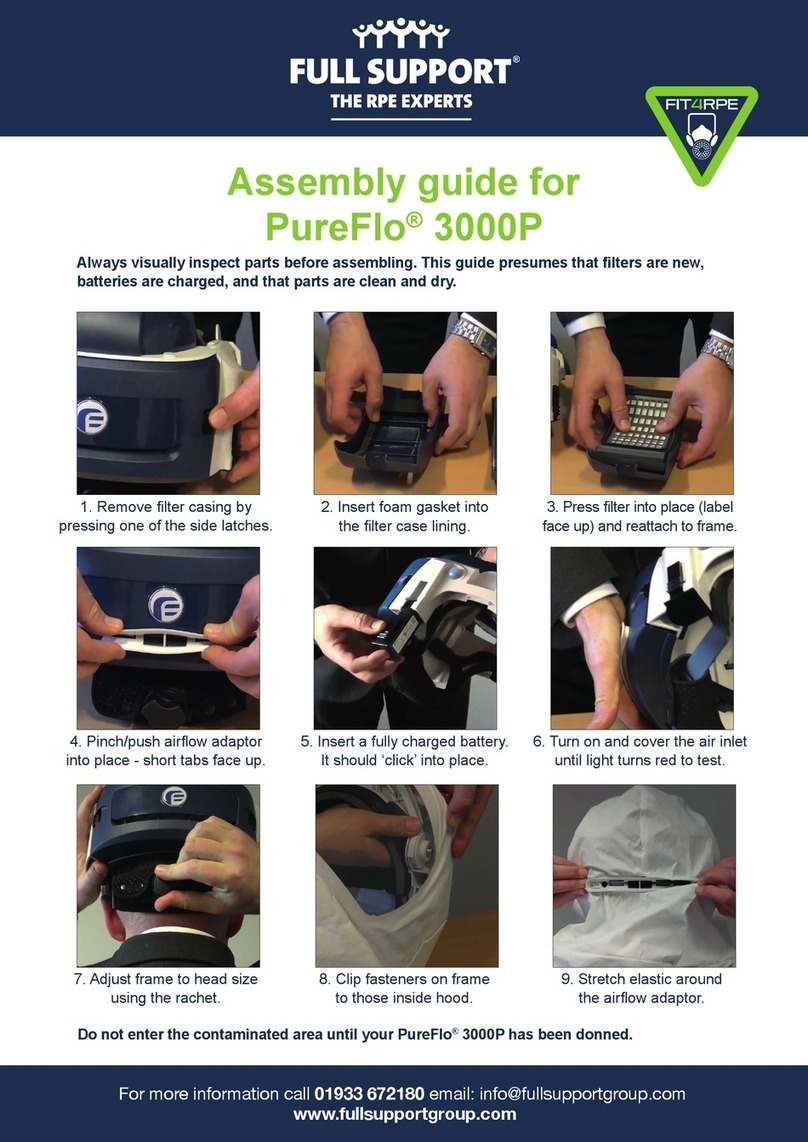
Full Support
Full Support PureFlo 3000P Assembly guide
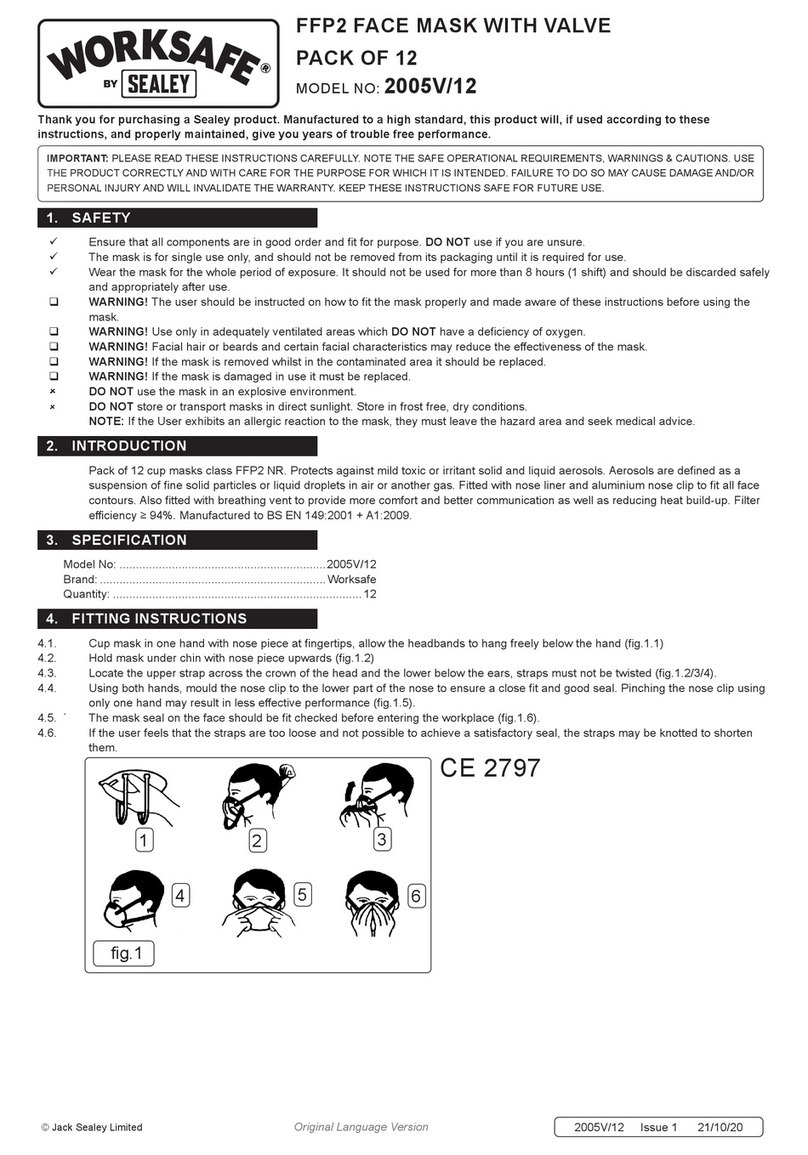
Sealey
Sealey Worksafe 2005V/12 quick start guide

MSA
MSA 3S small quick start guide
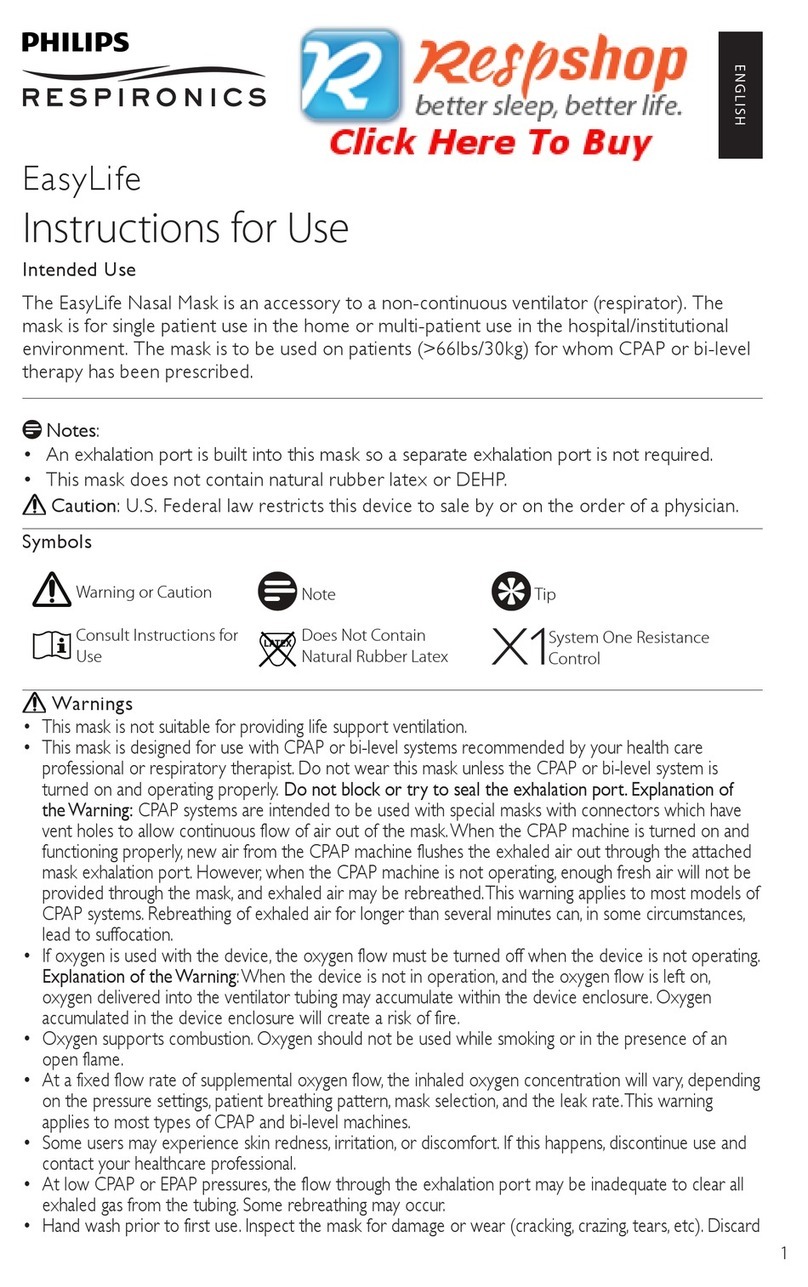
Philips
Philips Respironics EasyLife Instructions for use
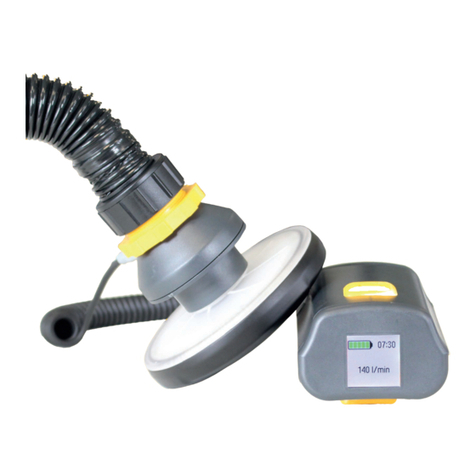
e-breathe
e-breathe SMARTBLOWER 322002100 instruction manual

Philips
Philips Respironics CoughAssist T70 Patient guide
